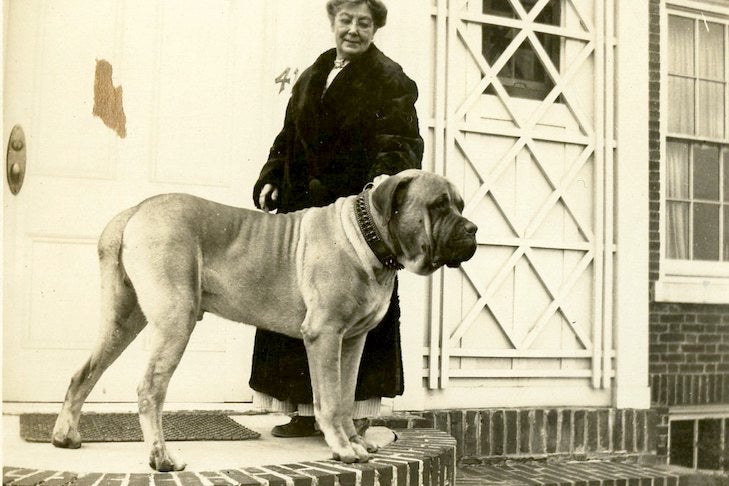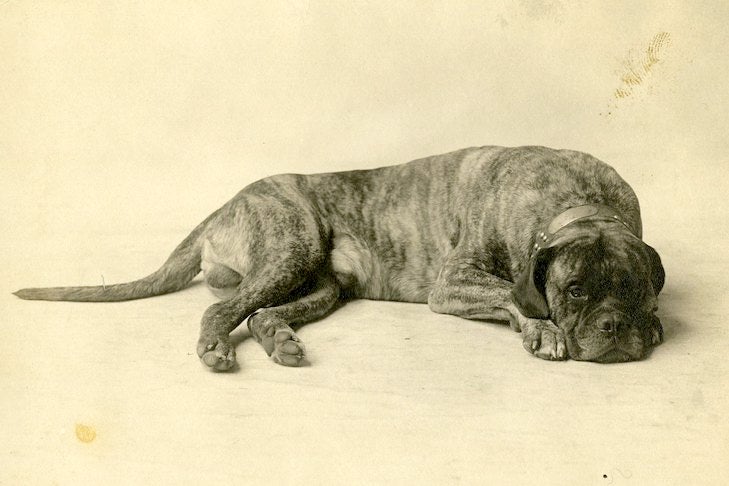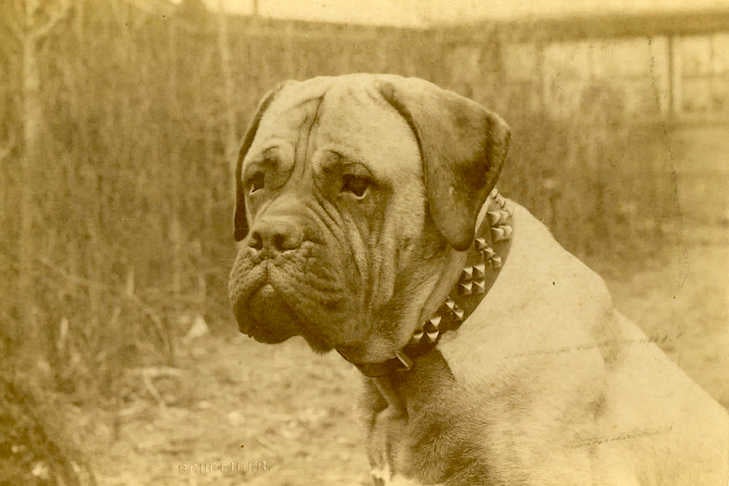
“What the Lion is to the Cat,” wrote Sydenham Edwards in 1800, “the Mastiff is to the Dog.”
It’s a brilliant analogy, and one that goes well beyond size and strength. But in truth, the king of beasts has nothing on the Mastiff when it comes to the unflinching sense of self that is the hallmark of true nobility. Perhaps only the lions of Disney’s imagination, with their “Lion King” gravitas, can hope to match the Mastiff in terms of sheer strength of character.
The Mastiff is “the noblest of the family; he stands alone, and all others sink before him,” Edwards, a natural history illustrator, continued in this famous passage from “Cynographia Britannica.” “His courage does not exceed his temper and generosity, and in attachment he equals the kindest of his race. His docility is perfect; the teazing of the smaller kinds will hardly provoke him to resent, and I have seen him down with his paw the Terrier or cur that has bit him, without offering further injury. In a family he will permit the children to play with him, and suffer all their little pranks without offence.”
Just Mastiff
The Mastiff – that’s it, just Mastiff, though unsuccessful attempts have been made to tack “English” in front of its name – has been known for millennia on the British Isles. The ancient Romans were particularly enamored of the breed, reportedly exporting some back to Italy so they could be used for fighting in the Coliseum – a fate that, ironically, fell to a good number of lions as well.
Much has been made of the Mastiff being the far-flung offspring of the prototypical mastiffs – with a small “M” – found in ancient art, like the famous Assyrian bas reliefs of heavy-boned dogs led by eunuchs that are housed at the British Museum. But modern DNA research has shown us that the idea of a single progenitor spawning all similar types of canines across the globe, from mastiffs to sighthounds, is simply false. Instead, these archetypal body styles – heavy boned and wrinkled, or light boned and aerodynamic, for example – emerged spontaneously in breed populations around the world. As a result, the Mastiff truly is a British original, owing its majesty to no one else.

Class-consciousness is as ubiquitous in English society as Wellingtons and mushy peas, and over the centuries the Mastiff has had its fair share of suffering as a result. During the Middle Ages, when the aristocracy exercised great control over open hunting land, commoners residing nearby were required to amputate several toes on the front feet of their dogs, hobbling them so they were unable to catch game. This barbaric practice, called “lawing,” was first done to Greyhounds. But by the late 1100s, Henry II required mastiffs to be lawed as well, as they were more athletic than the modern breed is today, and so more of a threat to game.
Massiveness and Loyalty
Those who saw England’s native Mastiff from afar appreciated the breed’s massiveness, which, it is important to mention, did not come from sheer inches alone. (The Mastiff standard is very clear on this, noting that the height of the dog should come from the depth of its body, rather than the length of its legs.) But no matter the century in which they live, those who spend time under a roof with this “mastie that keepeth the house” understand that its undiluted loyalty and supernatural tolerance of those weaker than itself are unique to the breed.
From the early 1400s comes the story of English knight Sir Piers Legh, who was wounded at the Battle of Agincourt. Legend holds that a female Mastiff stood sentry over him on the battlefield, preventing the advancing French soldiers from taking him prisoner – or worse. Though Legh was eventually rescued by his squire and servants, he died in Paris, never to return home. His canine guardian angel had better luck, and was brought to Legh’s ancestral home, Lyme Hall, where she whelped a litter of puppies and contributed to the famous Lyme Hall strain, the world’s oldest kennel of Mastiffs.
This irrepressible protective streak was frequently remarked upon by the Victorians, who delighted in juxtaposing the large, brooding Mastiff with smaller toy breeds, including the Pug, which, with its own wrinkles and thick skin, resembles a miniaturized Mastiff. But great pains were taken to note that a properly bred and tempered Mastiff would never take up a lopsided battle with a dog whose rashness was inversely proportionate to its size.

The Mastiff’s Survival & Longevity
If anyone in the Mastiff’s trajectory tended toward irritability, it was some prominent fanciers who across the centuries have argued about the various details of breed type, from ideal size to head style. The Mastiff itself has ebbed and flowed, requiring at times an infusion of new blood from other breeds to nudge it along during its lowest periods. Among the additions have been the Saint Bernard and Great Dane, as well as a sprinkling of Dogue de Bordeaux and even Tibetan Mastiff. The two world wars were particularly cruel to the Mastiff’s fortunes, as owners barely had enough rations to feed themselves, much less dogs that weighed as much as most of the humans in the household. In the aftermath of World War II, help came from North American fanciers, who had benefitted from the willingness of British breeders to sell them breeding stock in happier times. During the difficult postwar period, they sent some Mastiffs back across the ocean to help reconstitute the breed in its homeland.
Throughout the centuries, Mastiffs have retained an inexplicable and innate tenderness for women and children – any women and children, not necessarily their own. Mastiff owners report having to turn down the television volume if a police show is blaring in the background and a woman or child cries for help, lest the dogs in the household become wholly inconsolable.
Late in the evening, the Mastiff will quietly and deliberately patrol the home, ensuring all the humans are safe in bed, their gentle sleep-slowed breathing the soundtrack he appreciates most.
It’s this bundle of contradictions that endear the Mastiff to those who have fallen under the breed’s spell: The great size, and the correspondingly great restraint. The laidback attitude, and the bolt-upright reaction should a threat suddenly materialize. The sheer longevity of the breed, spanning millennia, and its many brushes with extinction, none of which have – thankfully – succeeded yet.
Take that, Simba.

